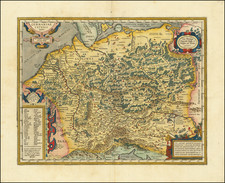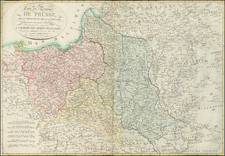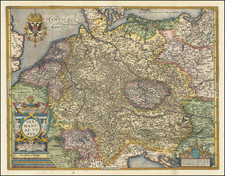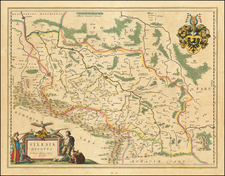An Important Map for the November Uprising.
This map of Poland from the period of the November Uprising, by Aleksander Zakrzewski, and lithographed in Warsaw in 1831 by Instytucie Litografenym Szkolnym, delineates the Kingdom of Poland within its historical borders with a specific focus on the territorial shifts of 1830. This map effectively charts the subdivisions of Poland in the early 19th century, notably demarcating the regions under Russian, Prussian, and Austrian administration. The map also covers parts of the Baltic and broader Eastern Europe. This was presumably to contrast Poland's historical extent with its much reduced and divided status in 1831.
The 1830s marked a period of considerable change for Poland, most significantly evidenced by the November Uprising of 1830–1831 against Russian rule. Zakrzewski's map captures the geopolitical realities of the time by illustrating the distinctive boundaries, cities, fortresses, and trade routes of Poland.
The key provides clarity on the map's symbols and colors. It identifies capital cities of the Kingdom and its provinces, along with other significant urban areas, lakes, fortresses, and trade routes. The various demarcations, illustrating areas under Russian, Prussian, or Austrian control, offer a measured reflection on the political landscape of Poland during this period.
In essence, Zakrzewski's work serves as both a geographical document and a subtle reflection of Poland's evolving political landscape during the early 19th century/
The November Uprising
The November Uprising, which took place between 1830 and 1831, was an armed rebellion in the heartland of partitioned Poland against the Russian Empire. It began on the night of 29 November 1830 in Warsaw when a group of young Polish officers from the local army academy, aggrieved by the increasing curtailing of the Polish autonomy within the Russian-controlled Congress Poland, staged a surprise attack against the Russian garrison in the city. Despite initial successes and broad support from the Polish populace, the uprising faced a numerically superior and better-equipped Russian army. The rebellion led to a series of battles that spread across the Polish territories, culminating in the capture of Warsaw by Russian forces in September 1831. In the aftermath, the Russian Empire tightened its grip on Poland, leading to increased Russification and the suppression of Polish culture and autonomy. The uprising, while unsuccessful in regaining independence, became a symbol of Polish resistance and a source of national pride.












![[Poland, Croatia, Slovenia, Hungary, Serbia, Romania, Ukraine, Bulgaria] (La discrittione della Transylvania et parte del l'Ungaria, et il simil della Romania)](https://storage.googleapis.com/raremaps/img/small/59225.jpg)
![Holsatiae Descriptio [with] Rugiae Usedomiae et Iulinae Wandalicarum insularum Vera descrtiptio 1584](https://storage.googleapis.com/raremaps/img/small/83746.jpg)
